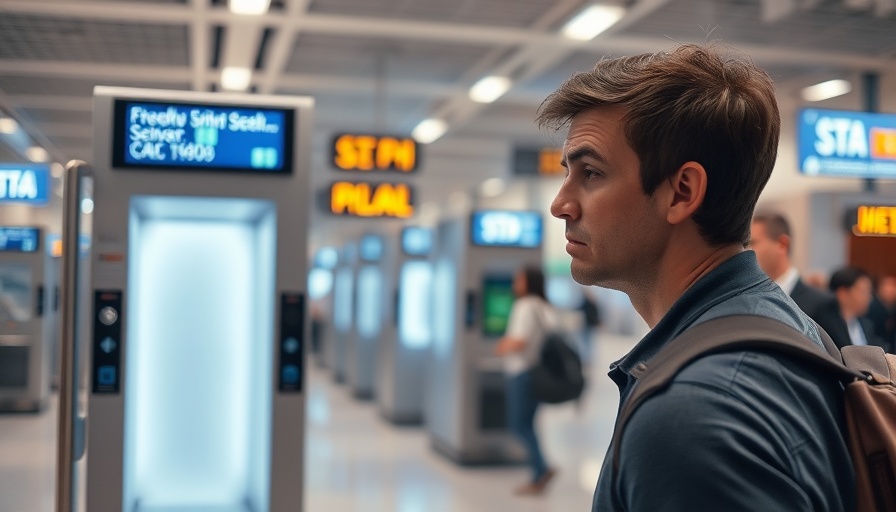
Understanding TSA Changes: New Rules for Travellers in 2025
As we approach 2025, travelers are faced with new TSA regulations that significantly alter airport security protocols. Navigating these changes efficiently can alleviate stress and streamline your airport experience. The recent video, AVOID These 7 TSA Line Mistakes in 2025 (New Rules!), outlines essential tips to navigate potential pitfalls that many travelers may not be aware of. Here we delve deeper into the specific rule changes and offer actionable insights to help you glide through security without a hitch.
In AVOID These 7 TSA Line Mistakes in 2025 (New Rules!), the discussion dives into vital tips for travelers navigating new TSA regulations, inspiring a deeper exploration of how these changes impact your travel plans.
The Trap of Last-Minute Airport Arrivals
One of the most talked-about mistakes is arriving at the airport just fifteen minutes before your flight, a trend touted on social media platforms like TikTok. While this may sound like a time-saver, it's risky business. Long lines can emerge unexpectedly, and unforeseen delays during security checks can easily cost you your flight. Even with TSA Pre-Check, unpredictability remains. With the implementation of new screening technologies that flag more bags for manual checks, this hasty arrival method may prove disastrous. Arriving at least an hour before domestic flights is not just a suggestion—it’s a necessity in today's fast-paced travel environment.
Federal Laws Override State Regulations: What to Know
A common misconception that can lead to serious dilemmas is believing that state laws supersede TSA rules. Many items legal in certain states, such as cannabis, can have severe consequences when transported through airport security due to federal regulations. In the past year, the TSA recorded nearly 7,000 firearms intercepted at security checkpoints. Travelers often overlook that numerous self-defense items, such as tactical pens and brass knuckles, are also prohibited, leading to alarming incidents and delays. As you prepare for your next trip, always check your packing against TSA's prohibited items list to avoid unwanted surprises at security.
The Ever-Present Liquids Rule: Don’t Get Caught Off-Guard
The TSA's '311 rule' regarding liquids is another area where travelers frequently stumble. Remember, all liquids, gels, creams, and pastes must be in containers no larger than 3.4 ounces and packed in a single, clear, quart-sized bag. Strangely enough, many food items (like peanut butter) fall under this as well. This rule applies uniformly across all U.S. airports, so don’t be lulled into a false sense of security if you’ve successfully flown internationally with larger containers. Additionally, as TSA rolls out new screening technologies, some rules may change on the fly—always stay informed.
Adapting to New Screening Technologies
Travelers should also prepare for advancements in security technology, particularly CT scanners that offer clear, 3D images of your bag’s contents. While they are designed to enhance efficiency by possibly eliminating the need to remove electronics or liquids, the introduction of such technology may initially cause delays as TSA agents adapt to these systems. It's wise to arrive prepared for possible manual checks even if you hope to breeze through.
Download Your Boarding Pass to Avoid Connectivity Issues
In a world where we often rely on Wi-Fi, travelers can fall into the trap of depending on airport connectivity for accessing digital boarding passes. Airport Wi-Fi can be inconsistent; as a precaution, it’s best to download your boarding pass prior to arriving at the airport. Taking the additional step of screening a screenshot of your boarding pass can save time at the gate, allowing a smooth boarding experience.
Mind the Prohibited Items: Knowledge is Key
Even experienced travelers may unwittingly pack prohibited items. It’s critical to review TSA's list of banned items before flying—bizarre items such as snow globes and smart luggage with non-removable batteries can create unexpected hold-ups. Vigilantly checking such lists can transform an anxiety-ridden travel experience into a pleasant one, keeping you one step ahead of security complications.
The Crucial Need for Real ID Compliance
Perhaps the most significant upcoming change is the requirement to possess a Real ID, effective May 7, 2025. Many travelers underestimate the necessity of this document—showing up with an ordinary driver’s license will result in denied entry through TSA. Those lacking an approved form of ID could miss their flight entirely, creating chaos on what should be a smooth day of travel.
Preparing for Your Next Trip: Stay Informed
As the landscape of air travel continues to evolve, preparation is key to enjoy a seamless security experience at the airport. By planning ahead, familiarizing yourself with TSA regulations, and embracing new technologies, you’ll be in the best position to dodge unnecessary hassles. Remember to stay updated on any changes and heed these fresh guidelines to travel smarter.
For those planning to embark upon travel adventures in 2025 and beyond, the importance of these insights cannot be overstated. Equip yourself with knowledge and respect TSA regulations to foster an efficient and peaceful journey.
 Add Row
Add Row  Add
Add 




Write A Comment